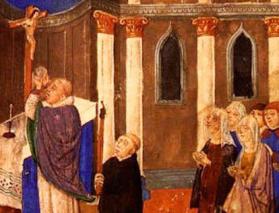Medieval biblical scholars read Scripture through the lens of the quadriga, fourfold sense of Scripture. Texts had a literal sense, an allegorical or Christological sense, a tropological or moral sense, and an anagogical sense.
In his recent study of de Lubac, Between Apocalypse and Eschaton, Joseph Flipper focuses on the last of these. Referring to Origen’s understanding of anagogy (as explained by de Lubac), he writes, “The Word of God, by entering into time, bestows a new meaning to temporal existence and establishes an ontological relationship to the past (the Old Testament) and also to the future (the eschaton). Origen’s allegory represents symbolically the relationship between the Old Testament and Christ. Anagogy, the last spiritual sense of Scripture, represents the relationship between the actions of the Word in history and their eschatological fulfillment at the end of time.”
This vision “systematized a pattern of understanding the end that influenced Christian thinking for a millennium.” On this view, “the eternal enters into history, drawing toward the eschatological consummation. For de Lubac, anagogy represented a way of seeing the transcendent in the midst of the world that could overcome the modern loss of the ‘sense of the sacred.’” Origen was able to hold heaven and earth, history and eschatology, together.
During the middle ages, anagogy split into two streams: “A medieval theological tradition inspired by Pseudo-Dionysius the Areopagite (fifth to sixth century) effectively lost its foundation in the history of salvation. Coincident with this development, a countertradition launched by Joachim of Fiore (1135–1202), emphasized history to the detriment of transcendence. In the Dionysian tradition, anagogy became a vertical mystical ascent to “higher realities”; in the tradition inspired by Joachim, it became the horizontal expectation of a utopian future.”
As de Lubac saw it, “modernity inherited both of these developments: on the one hand, a spiritual individualism that seeks to transcend the world by escaping from it; on the other hand, an apocalyptic mysticism that seeks total transformation of the world yet refuses the transcendent.” As anagogy fragmented, so did the Western understanding of time and history. Withdraw and revolution seemed to be the only options in a world where time was no longer seen as disclosing the eternal God, or as a step on the path toward a final consummation of all things.















